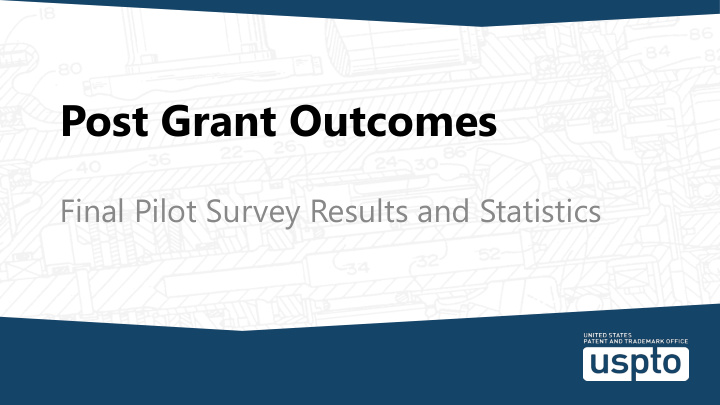



Post Grant Outcomes Final Pilot Survey Results and Statistics
Objectives of Post Grant Outcomes The purpose of this program is to learn from all post grant proceedings and inform examiners of their outcomes • Propose three objectives to accomplish this: – Enhanced Patentability Determinations in Related Child Cases Provide examiners with contents of PTAB AIA trial proceedings, including relevant • prior art and expert analysis Targeted Examiner Training – Data collected from the prior art submitted and examiner behavior will provide a • feedback loop on best practices – Examining Corps Education Provide examiners a periodic review of post grant (and post examination) • outcomes focusing on technology sectors
Objective 1 – Enhanced Patentability Determinations in Related Child Cases • A Pilot to: – Identify those patents being challenged at the PTAB under the AIA Trials that have pending related applications in the Patent Corps – Provide the examiners of those pending related applications access to the contents of the AIA Trial
Objective 1 – Pilot Statistics DISTRIBUTION OF PILOT APPLICATIONS BY TECHNOLOGY CENTER Technology Number of Pilot Center Applications 1600 3700 16% 1600 121 21% 1700 56 1600 2100 55 1700 1700 7% 2400 102 2100 2600 82 2400 2100 2800 65 2600 7% 3600 2800 3600 138 18% 3600 3700 160 2400 3700 Grand Total 779 13% 2800 2600 8% 10%
Objective 1 – Pilot Statistics cont. In the Office Action of the child case, did the examiner refer to any of the references cited in the AIA trial petition of the parent case? Yes 44% No 56% Based on 323 Survey Responses
Objective 1 – Pilot Statistics cont. If the examiner did not use any references cited in the AIA Trial Petition, why? The claims in my pilot case were substantially different from the parent case. 26% I disagreed with the 36% petitioner's analysis of the prior art and/or claims. I was able to find better art on my own. Other (please specify below) 29% 9% Common responses for “Other” include: -- The PTAB denied the IPR and the cited art wasn’t relevant to the instant application -- The AIA Trial was a Covered Business Method Review and only 101 was at issue -- The art cited in the IPR was used to negotiate an examiner’s amendment Based on 171 Survey Responses
Objective 1 – Pilot Statistics cont. Did the examiner write a new grounds of rejection using NPL or foreign art cited in the PTAB Petition? Yes, based on NPL art 7% No Other 90% 10% Yes, based on Foreign art 1% Based on 285 Survey Responses Yes, based on both NPL and Foreign art 2%
Objective 1 – Pilot Statistics cont. How did the examiner apply the AIA Trial reference(s) in the pilot application? 60 Common responses for “Other” include: 50 -- Art cited in the IPR was used to negotiate an examiner’s amendment 40 -- Arguments in a CBM Review were used to inform a 101 rejection 30 -- Expert testimony helped the examiner 20 better understand the prior art 10 Based on 127 Survey Responses 0 102 103 - Primary 103 - Secondary Relevant to the 112 - (e.g., Wands Other Reference Reference invention - Cited Factors Analysis) on 1449 Patent References NPL References Foreign References
Objective 1 – Pilot Statistics cont. Were the references from the AIA Trial cited in an IDS of the child application? 100% 90% 13 17 38 80% 70% 14 17 60% 24 50% 12 9 40% 30 30% 20% 25 21 27 10% 0% Patent references Foreign references NPL references Based on 129 Survey Responses None were already cited in the IDS Some were already cited in the IDS Most were already cited in the IDS All were already cited in the IDS
Based on 289 Survey Responses
Objective 1 – Pilot Statistics cont. To what extent did the pilot help the examiner? 49 To a Great Extent 47 91 To a Moderate Extent 96 64 To a Slight Extent 60 80 No effect 82 0 20 40 60 80 100 120 Assist in the completion of your office action? Save time locating relevant prior art? Based on 285survey responses.
Objective 2 – Targeted Examiner Training Data collected from the prior art submitted, resulting examiner • behavior and the survey, will provide a feedback loop on best practices Potential to educate examiners on: • – Prior art search techniques – Sources of prior art beyond what is currently available – Claim interpretation – PTAB proceedings and how it relates to child applications
Objective 3 –Examining Corps Education Leverage results of all post grant proceedings (and • post examination) to educate examiners on the process and results – Provide examiners a periodic review of post grant outcomes focusing on technology sectors – Utilize the proceedings to give examining corps a fuller appreciation for the process – Collecting Ex Parte PTAB decisions by technology to recognize trends for examiner education
Post Grant Outcomes Summary • Learn from the results of post grant proceedings • Shine a spotlight on highly relevant prior art uncovered in post grant proceedings • Enhance patentability of determination of related child cases • Build a bridge between PTAB and the examining corps
Next Steps • Develop training and best practices gleaned from pilot and implement corps-wide • Send your feedback to: PostGrantOutcomes@USPTO.GOV • More information at the PGO Pilot home page: http://www.uspto.gov/patent/initiatives/post-grant- outcomes-pilot
Recommend
More recommend